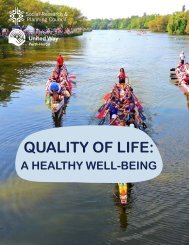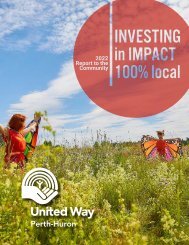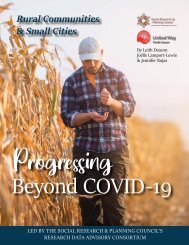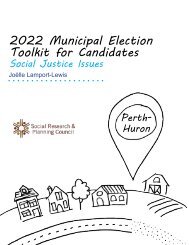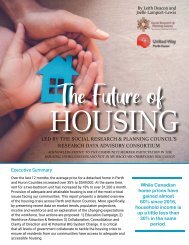2023-12-05 A Clean Environment
Create successful ePaper yourself
Turn your PDF publications into a flip-book with our unique Google optimized e-Paper software.
Forests and Wetlands Score Lower Than Provincial<br />
Average<br />
Forests, wetlands and riparian areas (trees, shrubs and plants near bodies<br />
of water) provide important support for the ecosystem. They serve as<br />
habitats for wildlife, shade and help purify air and water. They also protect<br />
soil, reducing the risk of erosion and flooding. Forests absorb greenhouse<br />
gases and act as a natural “air conditioner” for the land. Forest conditions<br />
are measured by assessing the area covered by forest within a watershed<br />
and the amount of forest interior providing habitat for wildlife. In addition<br />
to the number of trees, the variety of native species of trees and vegetation<br />
indicates the resilience of a forest and its surrounding area to climate<br />
change impacts. 23<br />
Between 2010 and 2015 approximately 353 hectares of forest<br />
were cleared for urban and agricultural uses in the Upper Thames<br />
River Conservation Authority area. During the same period, 781<br />
hectares of forest were gained thanks to forest succession and<br />
improvements in mapping. 24<br />
In the residential areas of Stratford, tree canopy percentages range from<br />
30–35%. This is higher than average urban forest numbers in Ontario. If<br />
industrial and commercial areas are added to the equation, the overall<br />
percentage comes down to 25–28% in Stratford.<br />
Conservation authorities in Perth and Huron all report on wetlands,<br />
although many other Ontario conservation authorities do not. The<br />
greatest threats to forests, wetlands and riparian areas are<br />
urbanization, changes to natural water levels, pollution, climate<br />
change and invasive species. There are three indicators used to assess<br />
forest conditions: per cent forest cover, per cent forest interior and per cent<br />
riparian zone forested. On average, all three of the conservation authorities<br />
covering Perth-Huron received C (fair) or D (poor) grades for both forest<br />
and wetland conditions. Overall, the grades were lower than the provincial<br />
average of C (fair). 25<br />
Conservation authorities can help by providing details on native species<br />
and include guides and information on their websites. Ausable Bayfield<br />
and Upper Thames River Conservation Authorities also offer programs to<br />
purchase native species at affordable prices. 26<br />
https://www.abca.ca/<br />
assets/files/Native_Plant_<br />
Guide_2021_LR.pdf<br />
https://thamesriver.on.ca/<br />
watershed-health/nativespecies/recommendedtrees-and-shrubs/<br />
RECOMMENDATIONS<br />
Landowners, community groups, governments and<br />
businesses increase the forest cover and improve the<br />
sustainability of woodlots and urban forests in consultation<br />
with local conservation authorities.<br />
Page 16 A <strong>Clean</strong> <strong>Environment</strong>





